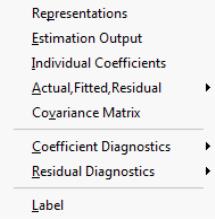Working With a Panel Cointegrating Equation
Once you estimate your equation, EViews offers a variety of views and procedures for examining the properties of the equation, testing, forecasting, and generating data. Generally speaking, these views and procedures are the same as those available in other estimation settings such as least squares estimation. In some cases there have been modifications to account for the nature of panel cointegrating regression.
Views
For the most part, the views of a cointegrating equation require little discussion.
For example, the shows the estimated coefficients and summary statistics of the equation, the view offers text descriptions of the estimated cointegrating equation, the displays the coefficient covariance, and the (, , ) offer statistics based on residuals.
That said, a few comments about the construction of these views are in order.
• The , , views of an equation only show results for the cointegrating equation and the long-run coefficients. In the representations view, the presence of individual trend coefficients is represented by the presence of the expression “[CX=DETERM]”. Similarly, the do not include any of the deterministics. Note also that the short-run dynamics added in DOLS estimation are not included in these views.
(Note that EViews while does not display the coefficients for the deterministics and short-run dynamics, the coefficients are used in constructing relevant measures such as fit statistics and residuals.)
• You may use the view to examine the estimated trend coefficients for each cross-section.
• The method used to compute residuals in the views and the views differs depending on the estimation method. For FMOLS, the values are not based on the transformed data; the residuals are derived by substituting the estimated coefficients into the original cointegrating equation and computing the residuals. For DOLS, the residuals from the cointegrating equation are adjusted for the deterministics and estimated short-run dynamics. Standardized residuals are simply the residuals divided through by the long-run variance estimate.
• The test statistics in the are computed using the pooled residual data and probably should be used only for illustrative purposes.
Procedures
The procs for an equation estimated using panel cointegrating regression are a subset of those found in least squares estimation.
While most of the relevant issues were discussed in the previous section (e.g., construction of residuals), you should note that:
• Forecasts constructed using the procedure and models created using procedure follow the view in omitting DOLS short-run dynamics. If you wish to construct forecasts that incorporate the short-run dynamics, you should use ordinary least squares to estimate an equation that explicitly includes the lags and leads of the cointegrating regressors.
• The forecast standard errors generated by the proc and those obtained from solving models created using the proc both employ the “S.E. of the regression” reported in the estimation output. This may not be appropriate.
• When creating a model from a panel equation with deterministic trends, EViews will create a series in the workfile containing the fitted values of the trend terms and will incorporate this series in the equation specification. If you wish to solve for your model with out-of-sample values, you will need to fill in the appropriate fitted values in the series.


